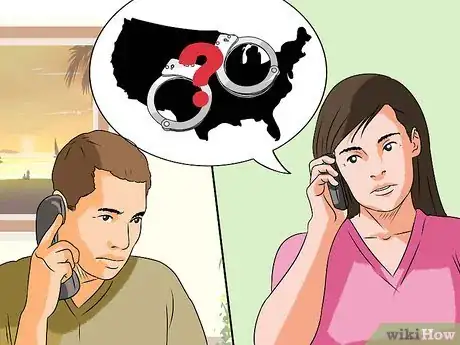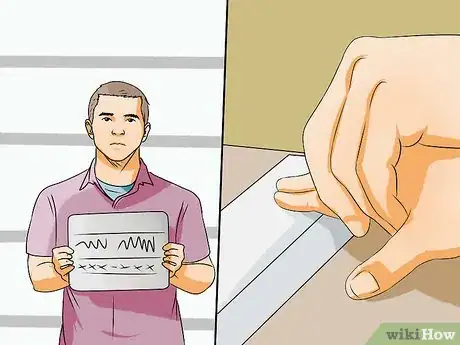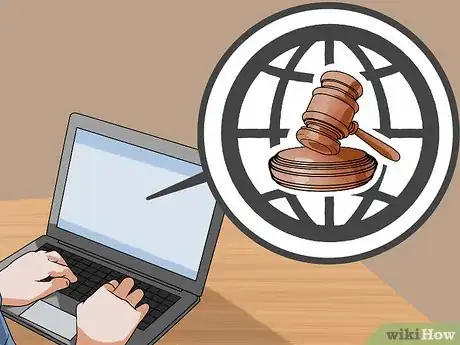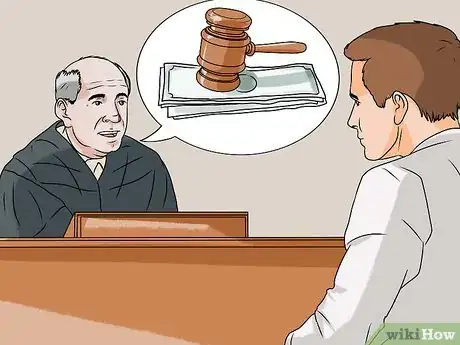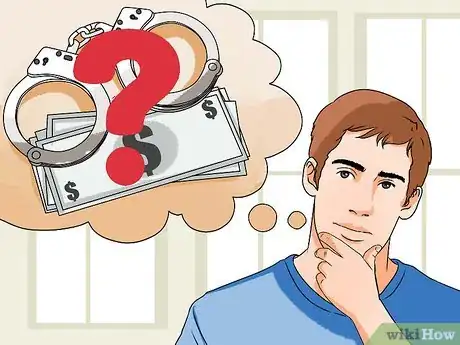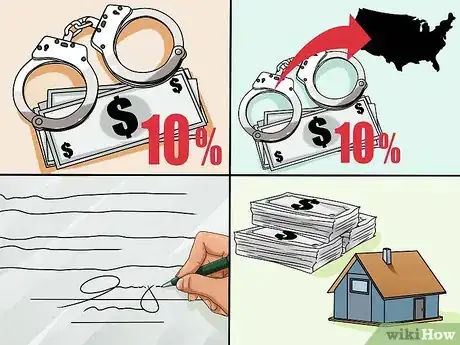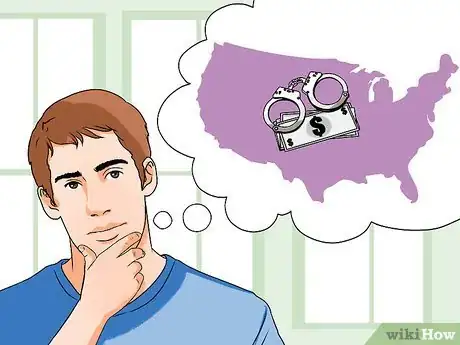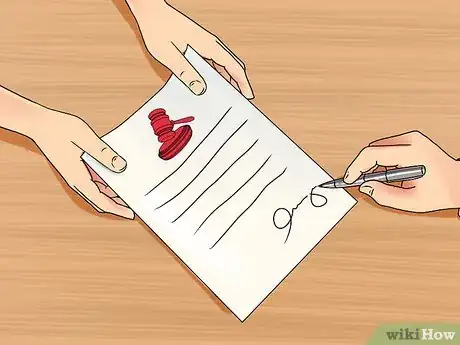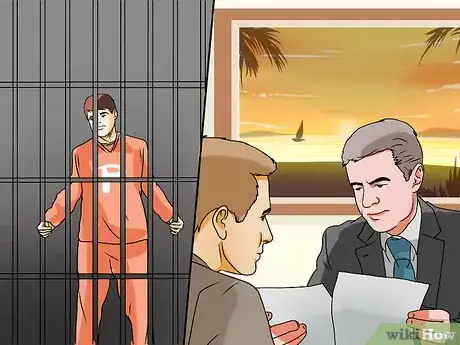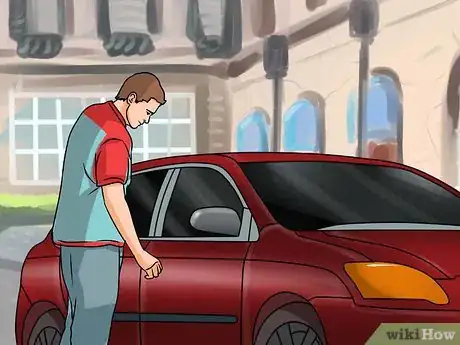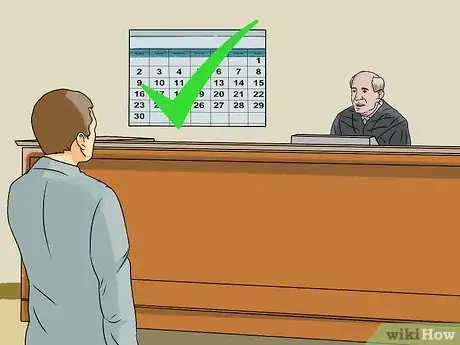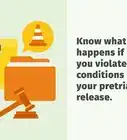This article was co-authored by Clinton M. Sandvick, JD, PhD. Clinton M. Sandvick worked as a civil litigator in California for over 7 years. He received his JD from the University of Wisconsin-Madison in 1998 and his PhD in American History from the University of Oregon in 2013.
This article has been viewed 229,189 times.
“Bail” is a deposit of money that courts require from criminal defendants. The court holds the deposit to ensure that the defendant keeps any court appearances. Bail amounts vary based on the charges and severity of the crimes and sometimes the courts do not allow bail at all. “Bailing someone out” is when you provide the money so that the defendant does not need to remain in jail.
Steps
Finding Out the Person’s Booking Status
-
1Find out if the person was detained. After arrest, a person will be released or jailed. If they're jailed, then they will need to be arraigned before a judge. The date of arraignment depends on the date of arrest: if it's a weekday, then arraignment could happen as soon as the next day or two. If the person was arrested on the weekend, they will have to wait until the following Monday.
- Some courts have weekend or night court that allows people to get arraigned sooner. At the arraignment, the judge will determine the person’s bail.
- Some offenses have bond amounts already set by law. If the person committed one of these offenses, then you can find out the bail amount ahead of time. Illinois, for example, sets bond amounts according to the charged offense because the state wants to avoid undue delay in freeing someone when the date and time of arrest makes it inconvenient to have the person arraigned.[1]
-
2Figure out where the person is detained. Large, metropolitan police departments may have different holding locations. Different agencies (the police department versus the sheriff’s department, for instance) have different holding facilities as well. The first thing you need to ask the person is where exactly they are detained.
- If the person hasn't contacted you, ask the arresting agency where the person is detained.
Advertisement -
3Learn the person’s booking status. Regardless of why the person has been detained, they will have to finish going through the booking process before being eligible to post bail. The booking process requires photographs, fingerprinting, and paperwork information that includes the person’s address, etc. Depending on how busy the agency is, someone may have to wait several hours for a turn through the booking procedures.
- The person may have no idea how long their wait will be. You can call the arresting agency after getting off the phone with the friend for a time estimate on the expected wait.
-
4See if the court website has any of the info you need. If you haven’t received a call from the person, but you know that they were arrested (if you were present at the time of arrest, for instance), then you can see if the court keeps an online database of the booking process. Many jurisdictions keep real-time information on the status of people being held in jail, so you might be able to search for the person by their last name to learn their location and booking status.
Using a Bail Bondsman
-
1Determine if bail is necessary. Bail will be set at the arraignment. In many situations, especially for minor offenders committing first-time offenses, the defending attorney (or public defender) may argue at the arraignment that the defendant should be released under their “own recognizance” (or "personal recognizance," called a PR bond). When a person is released under their own recognizance, it means that the court is trusting the person to return for the actual court date without holding a bond amount to ensure the person returns.
-
2Find out the bail amount. The base bail amount is determined by a “bail schedule,” which outlines recommended bail amounts for each type of criminal offense. Starting with the recommended bail, the defending attorney can argue to reduce the bail amount, and the prosecutor can argue to raise the bail amount from the recommended level as well. This is called a “bail motion.”
- Reasons a prosecutor may introduce a bail motion include:
- The person being a flight risk, which means that the court determines a person is not likely to return for their court date. Employment status, family in the area, and other community ties factor into this determination.
- The person presents a danger to society, which means that the court determines releasing a person may potentially put others in danger.
- If the accused represents neither of these factors, then the defending attorney may argue to reduce the bail amount below the standard bail schedule amount. However, one’s personal attorney will likely charge fees to appear and argue on the person’s behalf, which may even exceed the reduced bail amount.
- If the court tries to set a bail amount that far exceeds the bail schedule for the respective offense, then the defending attorney may also argue to lower the cost based on the accused’s 8th amendment rights, which require that bail not be excessive.
- Reasons a prosecutor may introduce a bail motion include:
-
3Understand the different types of bonds. There are many different kinds of bonds that you could post to get someone out of jail. The most common are:
- Private bail bonds. Here, you pay 10% of the full amount of the bail.
- Public bail bonds. Where private bonds are illegal, you pay 10% of the full amount of the bail to the state. In the federal court system and Washington, D.C., judges have the authority to authorize signature bonds if you cannot afford to pay bail.
- Signature bond or "own/personal recognizance." You agree to come to court and if you fail to show, then you must pay a financial penalty.
- Property bonds. Some states and the federal government allow these bonds, where you insure the bond with real property (such as your home). If the person skips bond, then you would lose your home.
-
4Check if a bondsman is an option in your area. There is little variation by state for bail requirements and no difference in bail factors because they are derived from the U.S. Constitution. One of the biggest variations involves whether a bail bondsman can post a bond in your state.[2] Illinois, Kentucky, Oregon, and Wisconsin do not currently allow bail bondsmen.[3]
- Due to the perceived predatory nature of the practice, many countries have outlawed it completely. Other U.S. states have shown interest in doing so as well.[4]
-
5Determine if the jurisdiction accepts signature bonds. Often, areas that have banned private bondsmen accept a “signature bond,” wherein a number of people, such as friends and relatives, sign on to verify that they will cover the bail amount without actually turning over funds. They are legally liable for the amount if the accused does not attend court proceedings. In order to verify if the local court accepts signature bonds, call ahead and see what types they accept.
- Typically these signature bonds will involve showing some sort of deed or title. They might even just be a promise that the signers will cover the bail if the defendant skips their court dates.
-
6Figure out if you need a bail bondsman. In instances where there is a bail amount, especially a high amount, many people do not have the available funds to post a bond. Bail bondsmen make their living by putting up money to fulfill the bail requirement. They then charge a percentage of the total bail as their fee.
- If you have the money, it may make more sense to pay the full bond amount than go to the bail bondsman. If you pay the full amount yourself, then you will get back more than you would if you go to a bail bondsman (assuming you make all of your appearances).
- There are usually a few bail bonds companies surrounding the jail or court in every city.
- There is usually very little variation in price between bail bondsmen. Bondsmen typically charge 10-15% depending on the type of crime or geographic location.
- For example, a 10% bond fee on a bail amount of $10,000 will mean that you pay $1,000 to the bondsman that you will not recover. Sometimes there is also a minimum fee amount, which would apply to some smaller bail amounts. If you can afford to put up the amount without the assistance of a bail bondsman, then it’s a far less expensive route to take.
-
7Have the bondsman ready ahead of time. If you know for a fact that you will need to use a bail bondsman to help post the bond, then you can actually contact the bondsman early in order to have the bondsman appear at the arraignment. If the bond is paid directly after the arraignment (the defendant’s first appearance in front of a judge when the bail amount is set), it can cut down significantly on the time the person spends in holding.
- Bondsmen usually have someone on staff at all hours. Call ahead and let them know when you need them. They can also help with local procedures or rules for bailing someone out. If you retain a lawyer, most criminal defense lawyers have bondsmen with whom they are familiar. They can prepare for a bondsman to be present at the arraignment for you.
- Situations where you can anticipate the necessity of a bail payment without any motions to reduce the amount include felony cases, misdemeanors that involve injury (“aggravated circumstances”), and multiple misdemeanors committed in succession. By simply knowing the charges the accused faces, you may be able to determine if the expected bail amount exceeds what you can afford without a bondsman.
- If you are the one jailed, then you will need a friend or family member to work with the bondsman. When you get out, you can then contact the bondsman and have the bond reassigned to you.
Paying Bail
-
1Pay the bond. Once the person is booked and you have a set bail amount, you can finally pay the bail to have the person released. The exact office you pay varies by location, but it is usually an officer for the police or sheriff’s department that made the arrest, or it may also be a clerk at the superior court in the jurisdiction of the appropriate county.
- You can pay bail with cash or a check, and many courts also accept credit cards.
- You typically only need the name of the accused when you go in to pay bail; however, the specific office may require additional case information, which you can usually find on the website for the appropriate court.
-
2Arrange a ride for the person. Whether the accused is released on their own recognizance or you post bail, the next most helpful thing you can do is arrange a ride for the person. They will be released from the holding facility without anything but what they had on them when booked. The person will appreciate having a way to get home, especially if they don't have cab fare on them.
-
3Ensure the person shows up for their court date. Bail amounts are essentially insurance policies to make sure that the person returns for their actual court date. Once the person shows up for a court date, the bail amount is returned to you in full. Make sure the person whose bail you paid shows up for this court date in order to have your bail amount returned, or you will not get the money back.
Warnings
- If the person got a life or death sentence by court, you cannot bail them out.⧼thumbs_response⧽
- Don't fight in the open court. This can lead to charges against you.⧼thumbs_response⧽
References
- ↑ https://www.cyberdriveillinois.com/publications/pdf_publications/sos_dop10.pdf
- ↑ http://www.americanbar.org/groups/public_education/resources/law_related_education_network/how_courts_work/bail.html
- ↑ http://www.bjs.gov/content/pub/pdf/prfdsc.pdf
- ↑ http://www.nytimes.com/2008/01/29/us/29bail.html?pagewanted=all
About This Article
If you get a call from someone asking you to bail them out of jail, ask them where they’re being detained and whether they’ve completed the booking process, which includes fingerprinting and having their photo taken. Depending on your state, the person may be able to tell your their bail amount. If not, you’ll need to attend the arraignment hearing to find out the exact amount. If you can’t afford the bail, consider working with a bail bondsman, who can put up the money for you. In return, they’ll charge you a fee, which is typically 10 to 15 percent of the total bail. Contact the bondsman as early as you can so they can appear at the arraignment. That way, the bail can be paid right after it’s issued, which will reduce the time that the person spends in holding. For more advice from our Legal co-author, including how to get your bail amount returned to you, keep reading.

